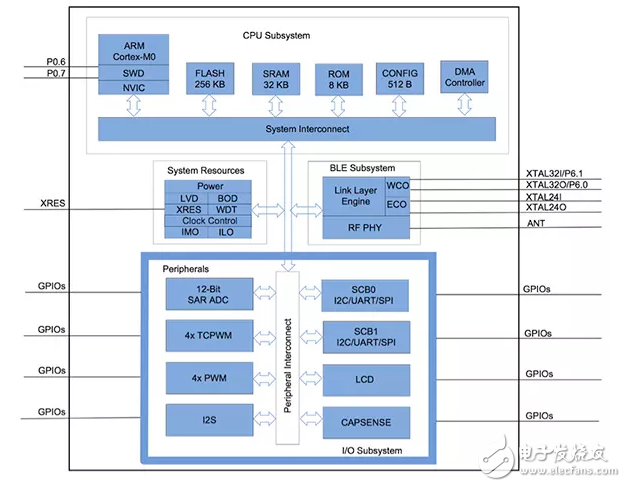
资料下载

蓝牙4.1,4.2和5兼容的蓝牙低功耗SoC和工具满足物联网的挑
蓝牙4.1,4.2和5兼容的蓝牙低功耗SoC和工具满足物联网的挑战
蓝牙低能量通过版本4.1,4.2和5的显着升级的目的是使短距离无线标准的物联网(物联网)无线应用的更好选择。这两部分组成的系列的第1部分介绍了这些升级和概述他们的优势。2部分,在这里,介绍了低功耗蓝牙SoCs,模块和工具,并讨论了它们的相对平衡作为一种设计方法。在该系列的结束,一个称职的设计师应该舒适开始蓝牙低能耗设计。
虽然一些芯片厂商现在提供低功耗蓝牙收发器片上系统(SoC),符合标准的最新版本,以利用所有的新功能是很棘手的。如果从空白表开始,开发人员必须应付相对复杂的RF外围电路设计,然后编写应用软件,优化他们的应用程序,但接口顺利与制造商的测试和验证蓝牙低能量协议软件(“堆栈”)。然后,他们必须获得监管符合他们的无线样机。选择一个模块可以通过消除外围电路的设计和合规性测试的过程,但这可以增加成本和解决方案的足迹。

Figure 1: Bluetooth low energy chipmakers generally take a highly integrated SoC approach. The solutions require few peripheral components and use ARM Cortex-M[x] processors to run both the stack and application code. The schematic shows Cypress Semiconductor’s CYBL1xx7x Bluetooth low energy SoC. (Image source: Cypress Semiconductor)
Chief among these subsystems is the CPU subsystem, typically comprising an embedded ARM processor and memory blocks. A direct memory access (DMA) controller enables certain operations to take place without using MCU resources. The embedded ARM core brings many advantages. These include wide adoption, a strong ecosystem, and the support of several popular integrated design environments (IDEs). The core has been specifically designed for low-power consumption and the device has sufficient computational overhead to concurrently run the stack and sophisticated application code. This eliminates the complexity, cost and space requirements of a separate application processor.
声明:本文内容及配图由入驻作者撰写或者入驻合作网站授权转载。文章观点仅代表作者本人,不代表电子发烧友网立场。文章及其配图仅供工程师学习之用,如有内容侵权或者其他违规问题,请联系本站处理。 举报投诉
- 相关下载
- 相关文章







